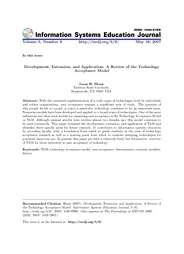Volume 5
Volume 5, Number 9 |
May 16, 2007 |

|
Jason H. Sharp
|
Abstract: With the continued implementation of a wide range of technologies both by individuals and within organizations, user acceptance remains a significant area of study. The question of why people decide to accept or reject a particular technology continues to be an important issue. Numerous models have been developed and applied to a broad scope of technologies. One of the most influential and often used models for examining user acceptance is the Technology Acceptance Model or TAM. Although seminal articles were written almost two decades ago, this model continues to be used extensively. This paper examines the development, extension, and application of TAM and identifies three specific areas for future research. It contributes to information systems educators by providing faculty with a foundation from which to guide students in the area of technology acceptance research as well as a starting point from which to evaluate emerging technologies for potential classroom use. In general, this paper provides a relatively brief, but informative, overview of TAM for those interested in user acceptance of technology.
Keywords: TAM, technology acceptance model, user acceptance, determinants, external variables, history
Download this issue: ISEDJ.5(9).Sharp.pdf (Adobe PDF, 11 pages, 502 K bytes)
Preview the contents: Sharp.j.txt (ASCII txt, 32 K bytes)
Recommended Citation: Sharp (2007). Development, Extension, and Application: A Review of the Technology Acceptance Model. Information Systems Education Journal, 5 (9). http://isedj.org/5/9/. ISSN: 1545-679X. (A preliminary version appears in The Proceedings of ISECON 2006: §2522. ISSN: 1542-7382.)